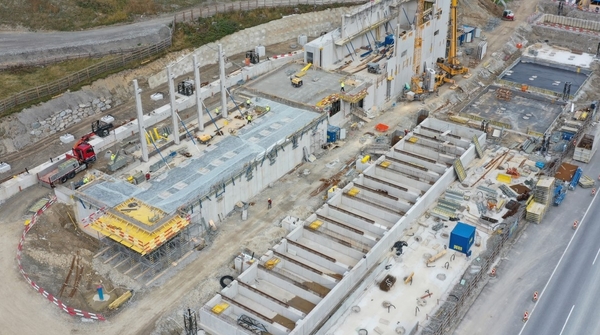Services
Location
Local construction supervision for structural engineering:
- Earthworks and special civil engineering works with large bored piles, soil nail and shotcrete wall and a reinforced earth construction.
- Shell construction work with the erection of the buildings and outdoor facilities in in-situ concrete and prefabricated reinforced concrete construction.
- Coordination of earthworks throughout the entire construction period.
- Handling of various finishing work and building equipment.
- Laying the 220 kV cable system to Italy.
Facts & Figures
- Company
- AEP Planung und Beratung GmbH
- Completion
- 2023
- Area of expertise
- Energy + Networks
- Construction style
- New building
- Construction type
- Electrical grid
- Work carried out
- Earthworks, special civil engineering, concrete construction, various finishing work, earthworks
- Client
- Austrian Power Grid AG
Project description
Construction Phase 1 – Site preparation – 08/2020 to 03/2021
The work to prepare the construction site included various earthworks and special civil engineering works. Due to the topographical situation, slope stabilisation work was required. The planned jump in the terrain in the western part of the facility is secured by a permanent soil nail and shotcrete wall. On the side facing the road to the east of the facility, a reinforced earth construction is used to retain the foundation of the facility. The facility is founded on a deep foundation consisting of approx. 500 large bored piles, i.e. pipe piles with a diameter of 90 or 120 centimetres each in confined groundwater and in-situ concrete construction. Parts of the bored piles were designed as overlapping bored pile retaining wall and serve as excavation support. During the construction of the floor slab and the basement, construction dewatering measures using drilled wells were necessary. Before being discharged into the receiving water, the extracted water was channelled to a water protection facility.
Construction Phase 2 – Construction methods – 03/2021 to 12/2022
The basement and the floor slabs of the GIS halls and the operations building were constructed using the reinforced concrete cast-in-situ construction method. The upper storeys were constructed using cavity walls and prestressed hollow core slabs. In the outdoor facilities, various transformer foundations and carriageways were constructed using in-situ concrete. A rail system was installed to transport the transformers. The cables were routed through prefabricated reinforced concrete cable channels. Various individual foundations for lightning rod poles, camera poles, etc. were constructed using in-situ concrete.
The roofs are designed as inverted roofs with bituminous or plastic-based (Kemperol) waterproofing that is covered with gravel. The hall facades are designed as ventilated panel facades, while the facade on the operations building is designed as a thermal insulation composite system. Doors and windows are aluminium designed in accordance with the guidelines for physical property protection. Floor coating, raised flooring, metalworking and various dry construction work will be carried out in the interior.
The two GIS halls are accessed through horizontal folding doors. Two overhead cranes, each with a load capacity of 5 tonnes, and two hoists, each with a load capacity of 500 kilograms, were installed to aid construction and for maintenance purposes. The entire system has an elaborate, close-mesh earthing and shielding system to dissipate any short-circuit currents.
Construction Phase 3 – 220 kV cable system – 2023
Construction phase 3 comprises the construction of the 220 kV cable system from the newly constructed Nauders substation to the Italian border. The transmission lines will subsequently be continued to the Glurns (Glorenza) substation on the Italian side. The work was awarded to the Prysmian company. The services include subsoil exploration along the route of the transmission line, controlled drilling in the area of road crossings and the underground installation of a 220 kV cable system. In the area near the Nauders substation, the 220 kV cables will be installed in underground conduits and laid up to the connection point in the cable cellar of the 220 kV GIS hall.
